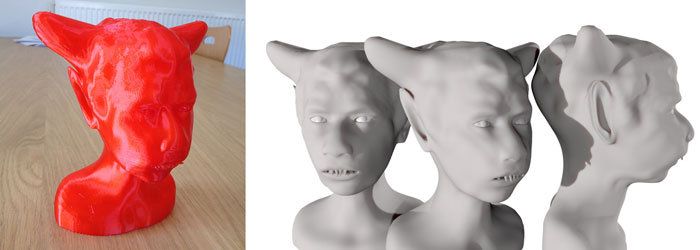This is an uplifting story with many strands that point to the positives of community engagement, productive networking, engaged education, designing in 3D, and, of course, a spot of 3D printing. The tip for this story came from Mike Willshaw, Managing Director of Radius Creative, a product design company, based in Hebden Bridge in West Yorkshire. Mike has recently fulfilled a 3D print job for a friend of his, Matt Howarth, and he thought I might be interested in the back story.
Always!
Thus I spent some time talking to Matt about his work and his move into the realm of education. Matt is a Director at Puppetman Productions, a company that traditionally specializes in live action video, animation and digital special effects. In recent times most notably being recognized for his work on the Discovery Kids series “Gross!” with a Royal Television Society Award.
As you might expect, Matt has long worked with a range of 3D digital tools for designing, one of his favourites these days being Blender. Having originally seen the free software in the late 90’s and dismissing it as not relevant for his work due to its limitations, when he tried it again a few years ago he found it had matured well, and he found it was “a useful tool for character development that stacked up well against some of the industrial 3D software packages I use.”
Matt is also engaged in various community projects, not least being involved in on the steering committee of “Creative Calderdale,” which is where he first met Mike. It was Mike that finally “crystallized the potential of 3D printing for me,” Matt told me. Mike acquired a MakerBot Rep 2 a couple of years ago for product development. They worked on a pixie sculpture together.
It was this, together with some of his other outreach programmes, that saw Matt move towards education. After talking with a number of teachers and pondering the best approach, the idea of a transferable 3D character design workshop developed. The challenge was to make it valuable, applicable within a school timetable, and yet simple enough to get going AND finish it to make it worthwhile for the children involved, thereby giving them a sense of achievement.
Matt is seeing some great results. He has taken the workshop into two schools so far and the feedback he is getting from teachers and kids alike is hugely positive. Working with Year 5’s to date (age 9-10), the most recent design workshop was at Greetland Academy in Halifax.
Initially Matt takes time to explain the basic concepts of character design, and he says “the kids are interested in this, particularly once they gather round to watch me develop the basic figure template that I set up on the school computers to demonstrate how to navigate the software. I then put them onto their own computers with the same template and we play a game that gets them navigating, themselves, pretty quickly. It’s good fun – for them and me.”
Matt continues, “But once I let them loose on the template themselves, that’s when the excitement goes up a gear or three. They just love it, and unlike adults, they have absolutely no fear, they just go for it and if they make mistakes, they laugh it off and go again. At the end of the day — these are the great principles behind good design.”
The design template Matt starts the children off with is just a simple humanoid head and shoulders. According to Matt this avoids time wasting and allows the children to engage almost immediately once he gives them their heads. They can start using their imaginations and are 3D sculpting within minutes. The template works within parameters, to avoid chaos on school servers, but the children are able to work on very precise surface details. “Blender has proven great for this,” Matt says.
The additional benefits of the workshop come through in discussions that touch on myriad of other subjects — biology, for example, when facial anatomy, including how eyes, muscles and other features can be realistically represented. Literacy and Maths also feature quite strongly, if subliminally. All the while, Matt is encouraging the children to think about the character they are developing – their looks and their emotions.
Once the 3D digital designs are complete, they are printed out in 2D and the school gets to vote for their favourite. The file of the winning design is then sent to Mike and is 3D printed out for the winning student and the school.
The following are some of the contenders from Greetland Academy:
But Anthony won the school vote, with this entry, which, considering he had been digitally 3D sculpting for little over an hour, is pretty impressive:

Matt, who has more perspective on these things than I, though, agreed, saying: “I think they did an excellent — if rather scary — job. Particularly considering that these sculpts are the result of just over an hour actual sculpting time, for class 5 pupils, with no prior experience.”
But perhaps Mr Pascall, a Year 6 Teacher & Director of ICT at The Greetland Academy, should have the last word here, the content of the parentheses, in particular, made me smile. His feedback went thus:
“Matt Howarth’s digital sculpting workshop for our Year 5 pupils was an important first step for the Greetland Academy in an area of Digital Technology and Design which looks set to change the way we work, communicate and collaborate in the near future. Matt clearly explained the real-world context of 3D design and printing and structured the workshop to give the children (and staff) an understanding both of its relevance, emerging importance and accessibility. Each participant enjoyed producing a 3D design, having keenly discussed the development processes involved. For some children the content and outcomes of this workshop may well represent a ‘spark’ of inspiration that makes Design Technology an aspirational focus for their futures.”




